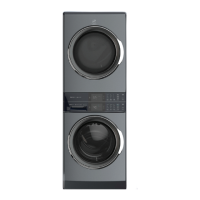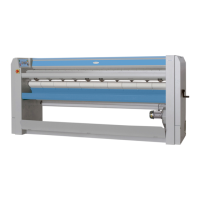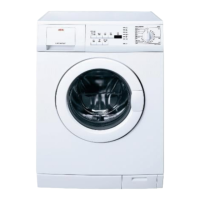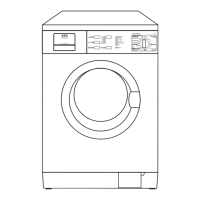Do you have a question about the Electrolux LAUNDRY and is the answer not in the manual?
Repairs to electrical appliances must be effected only by qualified personnel.
Always remove the plug from the power socket before accessing components.
Prefer ohmic measurements over direct voltage/current measurements where possible.
Be careful of sharp edges on metal components to avoid cuts.
Always drain any water before laying the appliance on the floor.
Never lay the appliance on its right side to prevent damage to electrical components.
Always perform final tests after completing repairs.
Explains the process of transferring dirt from fabrics to water using key elements.
Details the factors necessary for satisfactory washing results.
Lists and categorizes various natural and artificial fibres used in textiles.
Provides general guidance on washing different fabric types.
Offers specific recommendations for washing animal fibres.
Discusses the causes and effects of lime scale and rust spots in washing water.
Defines water hardness based on calcium and magnesium ion concentration.
Lists key components of detergents: surfactants, zeolites, alkalis, bleaches, whiteners.
Explains the roles of soap, surfactants, silicates, anti-foam, zeolites, alkalis, and bleaches.
Recommends temperature ranges for different soiling types and fabrics for optimal washing.
Describes how dirt is removed via combined mechanical and chemical actions.
Diagram and explanation of the Jetsystem's water flow and circulation.
Details the components and assembly of the door handle latch mechanism.
Shows various styling examples of washing machine control panels.
Lists different washing group types, load capacities, and spin efficiencies.
Details the assembly and components of the drum shaft bearing support.
Describes the dispenser with multiple outlets and 3 or 4 compartments.
Details the self-cleaning drain filter and its maintenance.
Explains the suppressor's function, symbols, diagrams, and checks for radiofrequency disturbance.
Lists conditions checked by the PCB before allowing the door to open.
Explains door release during power failure or faults.
Describes the PTC protective cut-out for the solenoid valve's current limitation.
General characteristics and functions of the pressure switch in water level control.
Diagrams the hydraulic connections for pressure switches within the machine.
General characteristics of the electronic pressure switch used for water level control.
Explains how the electronic pressure switch monitors water level via frequency changes.
Details on motor speeds, interchangeability, and general characteristics.
Explains how the motor's stator and rotor windings, brushes, and commutator work.
Explains motor functions for drum rotation and its asynchronous nature.
Describes the stator, rotor, and operating principle of induction motors.
How to check motor efficiency by measuring winding resistances.
Example of a wiring diagram for checking electrical connections.
Instructions on how to remove the work top for component access.
Steps to remove the electronic pressure switch.
Steps to remove the standard pressure switch.
Steps for removing the door and handle assembly.
Instructions for removing the door hinge.
Steps to access and remove the door safety interlock.
Instructions for removing the drive belt.
Steps for removing the drive pulley.
Instructions for removing the damper.
Steps for detaching the pressure chamber from the tub hose.
Instructions for removing the drain pump.
Steps for removing the inverter.
Lists various types of screwdrivers, wrenches, pliers, and cutters.
Repairs to electrical appliances must be effected only by qualified personnel.
Always remove the plug from the power socket before accessing components.
Prefer ohmic measurements over direct voltage/current measurements where possible.
Be careful of sharp edges on metal components to avoid cuts.
Always drain any water before laying the appliance on the floor.
Never lay the appliance on its right side to prevent damage to electrical components.
Always perform final tests after completing repairs.
Explains the process of transferring dirt from fabrics to water using key elements.
Details the factors necessary for satisfactory washing results.
Lists and categorizes various natural and artificial fibres used in textiles.
Provides general guidance on washing different fabric types.
Offers specific recommendations for washing animal fibres.
Discusses the causes and effects of lime scale and rust spots in washing water.
Defines water hardness based on calcium and magnesium ion concentration.
Lists key components of detergents: surfactants, zeolites, alkalis, bleaches, whiteners.
Explains the roles of soap, surfactants, silicates, anti-foam, zeolites, alkalis, and bleaches.
Recommends temperature ranges for different soiling types and fabrics for optimal washing.
Describes how dirt is removed via combined mechanical and chemical actions.
Diagram and explanation of the Jetsystem's water flow and circulation.
Details the components and assembly of the door handle latch mechanism.
Shows various styling examples of washing machine control panels.
Lists different washing group types, load capacities, and spin efficiencies.
Details the assembly and components of the drum shaft bearing support.
Describes the dispenser with multiple outlets and 3 or 4 compartments.
Details the self-cleaning drain filter and its maintenance.
Explains the suppressor's function, symbols, diagrams, and checks for radiofrequency disturbance.
Lists conditions checked by the PCB before allowing the door to open.
Explains door release during power failure or faults.
Describes the PTC protective cut-out for the solenoid valve's current limitation.
General characteristics and functions of the pressure switch in water level control.
Diagrams the hydraulic connections for pressure switches within the machine.
General characteristics of the electronic pressure switch used for water level control.
Explains how the electronic pressure switch monitors water level via frequency changes.
Details on motor speeds, interchangeability, and general characteristics.
Explains how the motor's stator and rotor windings, brushes, and commutator work.
Explains motor functions for drum rotation and its asynchronous nature.
Describes the stator, rotor, and operating principle of induction motors.
How to check motor efficiency by measuring winding resistances.
Example of a wiring diagram for checking electrical connections.
Instructions on how to remove the work top for component access.
Steps to remove the electronic pressure switch.
Steps to remove the standard pressure switch.
Steps for removing the door and handle assembly.
Instructions for removing the door hinge.
Steps to access and remove the door safety interlock.
Instructions for removing the drive belt.
Steps for removing the drive pulley.
Instructions for removing the damper.
Steps for detaching the pressure chamber from the tub hose.
Instructions for removing the drain pump.
Steps for removing the inverter.
Lists various types of screwdrivers, wrenches, pliers, and cutters.
| Brand | Electrolux |
|---|---|
| Model | LAUNDRY |
| Category | Laundry Appliance |
| Language | English |












